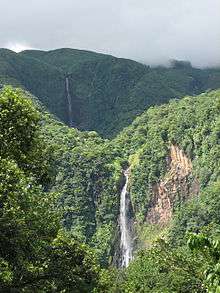Economy of Guadeloupe

The economy of Guadeloupe depends on agriculture, tourism, light industry, and services. It also depends on France for large subsidies and imports.
Tourism is a key industry; an increasingly large number of cruise ships visit the islands. The traditional sugarcane crop is slowly being replaced by other crops, such as bananas (which now supply about 50% of export earnings), eggplant, and flowers. Other vegetables and root crops are cultivated for local consumption, although Guadeloupe is still dependent on imported food, mainly from France. Light industry features sugar and rum production. Most manufactured goods and fuel are imported. Unemployment is especially high among the young. Hurricanes periodically devastate the economy.
Primary industries
Agriculture
In Guadeloupe, agriculture constituted 6 percent of GDP and employed 15 percent of the work-force in 1997, which equaled approximately 120,000. The main crops are sugarcane & bananas. Large sugar plantations that produce for both export and local consumption purposes continue to dominate. Sugarcane is grown on western and central parts of Grande-Terre due to its flat lands and rainfall of 1500 to 2500 mm. & on northeast section of Basse-Terre. There are rum distilleries to produce rum from sugar. Bananas are grown mainly on the
Animal husbandry
Cattle, goats, pigs & poultry are raised for local consumption and provided most of the requirements of animal products. The rearing of animals is done both on Grande-Terre & Basse-Terre.
Fishing
Offshore fishing is a traditional source of food, and the main catches. By the end of the 1990s, 11 fishing farms were registered in Guadeloupe and experiments are under way to catch and market fish in order to respond to growing demand. The 1997 catch was 10,518 tons, mainly marine fish with some small amounts of crustaceans and molluscs.
Industry
Manufacturing
In 1997, industry in Guadeloupe constituted 9 percent of GDP and provided employment for 17 percent of the labor force. Major industrial activities include sugar refining, rum distilling, food processing, cement and brick manufacture, mineral water bottling, beverage making, chemical making, textile manufacture & electronics assembly. Jarry has an industrial free-port.
Construction
The construction industry employs 12 percent of the workforce in Guadeloupe. Most of the construction sector is dominated by government in the form of public works. Such works provide an enormous boost to the economy and help relieve unemployment. Indeed, the 5,500 public work enterprises in the construction sector comprise 19 percent of all industrial enterprises and engage approximately 10 percent of the entire labor force. Construction has boomed with tourism to construct hotels, apartments and cottages.
Tertiary industries
In 1997, the service sector in Guadeloupe contributed 85 percent of GDP and provided employment for 68 percent of the labor force.
Tourism
Tourism accounted for 8.9 percent of GDP in Guadeloupe in 2000. Tourism is the major earner for Guadeloupe. In 2000, the number of tourists to Guadeloupe was 623,000, a decrease from 693,000 tourists in 1998. A high percentage of tourists are from France: 83.3% visit from metropolitan France, 10.8% come from the rest of Europe, 3.4% come from the United States, 1.5% come from Canada, 0.4% come from South America, and 0.6% come from the rest of the world.[1] 350 cruise ships visited Guadeloupe in 1998. Pointe-à-Pitre is a cruise ship port. Tourism provides jobs such as hoteliers, waiters, tour guides & taxi drivers.
Retail
There are many shopping centers especially in Pointe-à-Pitre where French perfumes, cosmetics & leather goods are sold along with local handicrafts as souvenirs. There is foreign direct investment such as McDonald's, KFC, and Subway have established operations in Guadeloupe. There are a number of small and medium-sized retail outlets. In 2000, three hundred new outlets, mostly in the leisure and supermarket sectors, were created in Guadeloupe alone.
Economic data
GDP: real exchange rate - US$9.74 billion (in 2006)[2]
GDP - real growth rate: NA%
GDP - per capita: real exchange rate - US$21,780 (in 2006)[3]
GDP - composition by sector:
agriculture:
15%
industry:
17%
services:
68% (2002 est.)
Population below poverty line: NA%
Household income or consumption by percentage share:
lowest 10%:
NA%
highest 10%:
NA%
Labour force: 125,900 (1997)
Labour force - by occupation: agriculture 15%, industry 20%, services 65% (2002)
Unemployment rate: 27.8% (1998)
Budget:
revenues:
$296,3 million
expenditures:
$296,3 million, including capital expenditures of $112,5 million (1996)
Industries: construction, cement, rum, sugar, tourism
Industrial production growth rate: NA%
Electricity - production: 1,165 kWh (2003)
Electricity - production by source:
fossil fuel:
100%
hydro:
0%
nuclear:
0%
other:
0% (1998)
Electricity - consumption: 1,084 TWh (2003)
Electricity - exports: 0 kWh (2003)
Electricity - imports: 0 kWh (2003)
Agriculture - products: bananas, sugarcane, tropical fruits and vegetables; cattle, pigs, goats
Exports: US$676 million (in 2005)[2]
Exports - commodities: bananas, sugar, rum
Exports - partners: France 60%, Martinique 18%, US 4% (1997)
Imports: US$3.102 billion (in 2005)[2]
Imports - commodities: foodstuffs, fuels, vehicles, clothing and other consumer goods, construction materials
Imports - partners: France 63%, Germany 4%, US 3%, Japan 2%, Netherlands Antilles 2% (1997)
Debt - external: $NA
Economic aid - recipient: $NA; note - substantial annual French subsidies
Currency: 1 Euro (currency sign: €; banking code: EUR) = 100 cents
Exchange rates: euros per US$1 – 1, 3002 (February 2005), 0.9867 (January 2000), 0.9386 (1999); French francs (F) per US$1 – 5.65 (January 1999), 5.8995 (1998), 5.8367 (1997), 5.1155 (1996), 4.9915 (1995)
Fiscal year: calendar year
References
- ↑ "Guadeloupe – Economie" (in French). 1998. Retrieved 10 June 2006.
- 1 2 3 (French) INSEE-CEROM. "Les comptes économiques de la Guadeloupe en 2006" (PDF). Retrieved 2008-01-20.
- ↑ (French) INSEE-CEROM. "Tableau de bord économique de la Guyane" (PDF). Retrieved 2008-01-20.
See also
- Economy of France in: French Guiana, French Polynesia, Guadeloupe, Martinique, Mayotte, New Caledonia, Réunion, Saint Barthélemy, Saint Martin, Saint Pierre and Miquelon, Wallis and Futuna
- Taxation in France
- Economic history of France
- Poverty in France
.svg.png)